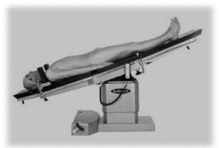Trendelenburg position
Not to be confused with Trendelenburg's sign.

Old depiction of the Trendelenburg position

Trendelenburg position In Surgery
In the Trendelenburg position, the body is laid flat on the back with the feet higher than the head by 15-30 degrees, in contrast to the reverse Trendelenburg position, where the body is tilted in the opposite direction. Trendelenburg is a frequently used position in surgery, especially of the abdomen and genitourinary system. It allows better access to the pelvic organs as gravity pulls the intra-abdominal organs away from the pelvis. The position was named for the German surgeon Friedrich Trendelenburg (1844 – 1924).[1] Despite the lack of evidence to support it, the Trendelenburg position is often used for patients in hypovolemic shock, with the goal of maintaining blood flow to the brain.[2]
Current uses
- The Trendelenburg position is used to treat a surgical air embolism by placing the right ventricular outflow tract inferior to the right ventricular cavity, causing the air to migrate superiorly into a position within the right ventricle from which air is less likely to embolize.[3]
- The Trendelenburg position along with the Valsalva maneuver, termed as modified-Valsalva maneuver, is used for the cardioversion of supraventricular tachycardia.[4]
- The Trendelenburg position is helpful in surgical reduction of an abdominal hernia.[5]
- The Trendelenburg position is also used when placing a central venous line.[6] The Trendelenburg position uses gravity to assist in the filling and distension of the upper central veins when placing a central line in the internal jugular or subclavian veins. It is also used in the placement of an external jugular peripheral line for the same reason. It plays no role in the placement of a femoral central venous line.
- The Trendelenburg position is also used in respiratory patients to create better perfusion.[7]
- The Trendelenburg position has occasionally been used to produce symptomatic relief from septum posticum cysts of the subarachnoid space in the spinal cord, but does not bring about any long term benefits.[8]
- The Trendelenburg position may be used for drainage images during endoscopic retrograde cholangiopancreatography.[9]
Controversial uses
- People with hypotension (low blood pressure) have historically been placed in the Trendelenburg position in hopes of increasing their cerebral perfusion pressure (the blood pressure to the brain). A 2005 review found the "Literature on the position was scarce, lacked strength, and seemed to be guided by 'expert opinion.'"[10] A 2008 meta-analysis found adverse consequences to the use of the Trendelenburg position and recommended it be avoided.[11] However, the passive leg raising test is a useful clinical guide to fluid resuscitation and can be used for effective autotransfusion.[12]
- The Trendelenburg position used to be the standard first aid position for shock.[13]
- The Trendelenburg position was used for injured scuba divers.[14] Many experienced divers still believe this position is appropriate, but current scuba first aid professionals no longer advocate elevating the feet higher than the head. The Trendelenburg position in this case increases regurgitation and airway problems, causes the brain to swell, increases breathing difficulty, and has not been proven to be of any value.[15] "Supine is fine" is a good, general rule for victims of submersion injuries unless they have fluid in the airway or are breathing, in which case they should be positioned on the side.
See also
- Trendelenburg gait
- Trendelenburg's sign
- Fowler's position
- High Fowlers position
- Recovery position
- Semi-Fowlers position
References
- ↑ Enersen, Ole Daniel. "Trendelenburg's position". Whonamedit.com. Retrieved 2009-03-04.
- ↑ Johnson, S; Henderson, SO (2004). "Myth: the Trendelenburg position improves circulation in cases of shock" (PDF). Canadian Journal of Emergency Medicine. 6 (1): 48–9. PMID 17433146.
- ↑ Orebaugh SL (1992). "Venous air embolism: clinical and experimental considerations". Crit Care Med. 20: 1169. doi:10.1097/00003246-199208000-00017. PMID 1643897.
- ↑ "Postural modification to the standard Valsalva manoeuvre for emergency treatment of supraventricular tachycardias (REVERT): a randomised controlled trial.". Lancet. doi:10.1016/S0140-6736(15)61485-4. PMID 26314489.
- ↑ Buchwald H (1998). "Three helpful techniques for facilitating abdominal procedures, in particular for surgery in the obese". American Journal of Surgery. 175 (1): 63–4. doi:10.1016/S0002-9610(97)00233-X. PMID 9445243.
- ↑ Central Venous Access Imaging at eMedicine
- ↑ Powers SK, Stewart MK, Landry G (1988). "Ventilatory and gas exchange dynamics in response to head-down tilt with and without venous occlusion". Aviation, Space, and Environmental Medicine. 59 (3): 239–45. PMID 3355478.
- ↑ Teng P, Rudner N (1960). "Multiple arachnoid diverticula". Archives of Neurology. 2: 348–56. doi:10.1001/archneur.1960.03840090112015. PMID 13837415.
- ↑ Leung, Joseph. "Fundamentals of ERCP". In Cotton, Peter B. ERCP. GastroHep.
- ↑ Bridges N, Jarquin-Valdivia AA (2005). "Use of the Trendelenburg position as the resuscitation position: to T or not to T?". American Journal of Critical Care. 14 (5): 364–8. PMID 16120887.
- ↑ Kettaneh, Nicolas (October 30, 2008). "Use of the Trendelenburg Position to Improve Hemodynamics During Hypovolemic Shock". BestBets.
- ↑ Terai C, Anada H, Matsushima S, Kawakami M, Okada Y (1996). "Effects of Trendelenburg versus passive leg raising: autotransfusion in humans". Intensive Care Medicine. 22 (6): 613–4. doi:10.1007/BF01708113. PMID 8814487.
- ↑ Johnson S, Henderson SO (2004). "Myth: the Trendelenburg position improves circulation in cases of shock". CJEM. 6 (1): 48–9. doi:10.1017/S1481803500008915. PMID 17433146.
- ↑ Stonier, JC (1985). "A study in prechamber treatment of cerebral air embolism patients by a first provider at Santa Catalina Island". Undersea Biomedical Research. Undersea and Hyperbaric Medical Society. 12 (1 supplement). Retrieved 2009-03-19.
- ↑ Dysbarism at eMedicine
External links
| Wikimedia Commons has media related to Trendelenburg position. |
- Illustration of position in comparison to other positions
- Human Kinetics' Victim Positioning
- According to The Canadian Journal of Anesthesia
This article is issued from Wikipedia - version of the 11/13/2016. The text is available under the Creative Commons Attribution/Share Alike but additional terms may apply for the media files.